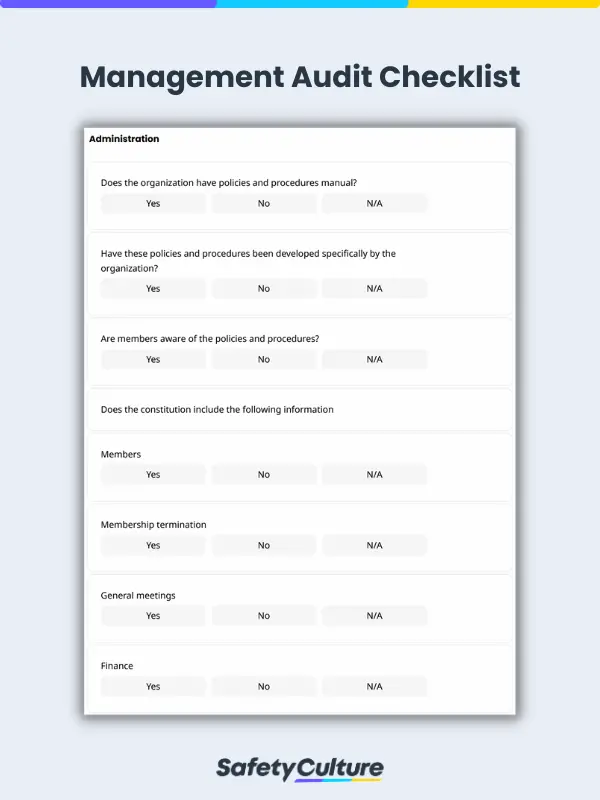What is a Management Audit?
A management audit is a systematic approach that aims to analyze the effectiveness of management systems of an organization. It assesses how management teams operate the business and evaluate the results of implemented policies, protocols, and procedures in carrying out corporate objectives and safety standards.
A comprehensive management audit usually involves assessing department processes, conducting individual assessments on team members, and looking at the overall performance of the management department to determine what can be improved and what the team does right.
While individual assessments may be part of the audit, the entire goal of a management audit is to assess the performance of the team as a whole and not single out any individual.
Importance
Management audits are a very important part of continuous improvement and have a positive effect on the organization as a whole. This is because a management audit allows you to find performance lapses with your management team. That way, you can find better ways to utilize resources, designate tasks, and get the most out of your workforce. On top of that, it makes it easier for the organization to make decisions geared toward improving performance and productivity.
A well-implemented management system can empower a management team to work and communicate effectively, minimize risk, lower employee dissatisfaction, and reduce wastage.
Key benefits of performing a management audit are the following:
- Identify strong and weak points of the management system;
Improve communication protocols; - Minimize cost of production by eliminating wastage;
- Utilize manpower efficiently;
- Improve safety and compliance standards;
- Identify defects and irregularities from the administration; and
- Determine better solutions to achieve the desired goals.
How Management Audits Work
Performing an internal management audit is a tricky task. This is because when you designate employees to conduct the audit, their personal biases may affect the outcome of the audit and produce skewed results, which can affect the decisions you make as a result of the audit. This is why most companies opt to hire third-party organizations to conduct the audit for them and ensure that the results are fair and unbiased.
When hiring a third-party organization for a management audit, one or two consultants would visit the business premises and evaluate management practices and interview individuals. That way, they can gauge the performance of the management team and provide you with accurate recommendations and results.
Key Areas of a Management Audit
There are various areas of a management audit since these assessments take a look at the management team as a whole. On top of that, the areas of the audit may also vary depending on the needs of your organization and your industry. That said, here are some of the typical areas to cover when conducting a management audit:
Strategic Planning
Since management teams are in charge of strategic planning, a key area of the audit should be how well the team creates strategies and see if it aligns with the company’s vision and goals and if it’s effective. Some methods to use during strategic planning include PESTLE analysis and SWOT analysis.
Governance
It’s also important that the audit includes an assessment of the team’s leadership abilities to check if they are pushing the rest of the company in the right direction.
Organizational Structure
The company’s organizational structure has a major effect on communication, coordination, and efficiency. This is why most management audits also cover this area comprehensively.
Financial Management
It’s critical for the audit team to assess the management’s financial management capabilities. The company’s resources should always be properly allocated and distributed, and a comprehensive management audit should check for that.
Operational Efficiency
The last major area is operational efficiency. This allows auditors to check how well the organization works with the management team at the helm and determine any potential improvement areas.
How to Conduct a Management Audit
Conducting a management audit is a complex task that may look different for every team and organization. However, there are still standard steps that all management audit teams have to perform to ensure that they conduct the audit properly. These steps include:
Step 1: Plan the audit
Before beginning an audit, it’s crucial to create a comprehensive plan that includes the scope of your audit. This includes determining the primary objective of the audit, listing all the information you need to learn from the audit, and how you’re going to implement the audit.
Step 2: Choose questions to ask
Though this may seem simple, asking people the right questions will surely make a difference. Once questions are finalized, proceed with interviewing the organization’s employees. If using only one set of questions for employees and another one for management, note the differences in answers across different departments and job types.
Step 3: Gather Relevant Data & Validate information
The next step is gathering data. This is done by interviewing employees and members of the management team, and thoroughly assessing various business processes. Which is followed by validating the information by observing. Whether the observation is only for the day or a longer period of time, use a checklist of items to look out for such as problem areas or flagged issues. Ideally, this should be a digital checklist so that it’s easy to access and edit on-the-go.
Step 4: Check existing documents
Examine documents such as financial statements and other records of the organization’s processes. In addition to the evidence obtained in the previous steps, these documents can back up the auditor when presenting their findings to the organization’s management team.
Step 5: Analyze the data
After gathering the data, the team must analyze all of their findings. Typically, auditors gather large amounts of data during audits and need to examine the data to determine what it means in the larger scope of things. That way, they can identify improvement areas, strengths, and even best practices for team members to follow. This step can be a headache when using pen and paper for conducting the audit. This can be made easier with an audit management software. Though it can be difficult for old-school auditors to transition, doing so will not only help them but also the organizations they audit in understanding audit results.
Step 6: Present Your Findings
The most important part of a management audit is the report that auditors create at the end. This report contains all of the data they gathered, including their interpretation. Typically, the report also has recommendations for the best way for the management to move forward based on the data gathered during the audit.
Step 7: Implement the Recommended Actions and Follow-Ups
Lastly, the management team needs to interpret the report from the auditors and implement their recommendations. Since the recommendations are based on data, it’s much easier to make smart decisions that allow the management team to lead the company toward its goals more efficiently.
Step 8: Keep Track of the Progress
The last step of a management audit includes conducting follow-ups to ensure that everyone in the organization—from management to line workers—are following the best practices recommended by the audit. This step also involves periodic management reviews for continuous improvement.
FAQs About Management Audit
The frequency of management audits varies from organization to organization. So, it’s important to assess the needs of the organization to determine if you should conduct the audits every few years, annually, or biannually.
The main principles of management audit include the following:
- Objectivity
- Accuracy
- A systematic approach
- Continuous improvement
- Independence
Typically, management audits are handled by third-party organizations or teams. This is to ensure a fair assessment and removes any potential biases that arise when conducting audits internally. Organizations can also perform internal management audits provided they select impartial auditors to carry out the process.
Typically, management audits can take between a few weeks to a few months to complete. This depends on the size of the organization, the needs of the management team, and other contributing factors. The key is to allot sufficient time to review all aspects of management.
Some of the main challenges auditors face during management audits include:
- Availability of data
- Resistance from management teams
- Lack of independence
- Ambiguous scope of the audit
- Complex organizational structures
Management auditing involves the capturing of significant notes, interviews, and photo evidence in order to check if protocols are meeting company objectives. More time is often spent on data entry and paperwork as opposed to identifying observations and actioning recommendations.
Management audit is developed by a former manager of Leyland Motors and a management lecturer at Cambridge University, T. G. Rose, in 1932. Queens University School of Business professor William P. Leonard followed soon after. These endeavors both aim to establissh a comprehensive review of the management effectiveness of their respective entities.
This management audit example reviews the top management of the Universal Life company—starting from the administration, finance, insurance, policy, personnel management, contracts, hazard identification and control, event management, and legislation and industry standards. View this management audit PDF to see more.



